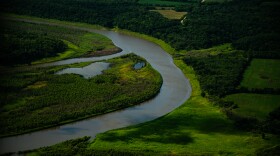Samantha Williams laid a long tube, several bottles and a waterproof notebook on flat rocks next to a boat ramp in southwest Iowa. The East Nishnabotna River flowing past her reflected an overcast October sky.
“I usually start out with the pH test strip, the nitrate, chloride, and then I do the phosphate test, dissolved oxygen, and then temperature and turbidity,” she explained.
Williams voluntarily collects water quality data each month at 10 sites across Montgomery County and shares her findings on Clean Water Hub, an online dashboard managed by the Izaak Walton League of America.
She also records what she hears and sees. When Williams became a “citizen scientist” in June 2024, she said this section of the river was silent.
“It really wasn’t until the beginning of this year that you could hear the birds. You could see the fish in the water, just slowly [see] the life come back,” Williams said.
The river south of Red Oak was recovering from Iowa’s fifth largest recorded fish kill.
In March 2024, a valve left open at the NEW Cooperative facility in Red Oak released 1,500 tons of liquid nitrogen fertilizer into the East Nishnabotna River. Wildlife officials in Iowa and Missouri estimated 800,000 fish died from the 60-mile spill, which reached the Missouri River near Peru, Neb.
The Iowa Department of Natural Resources (DNR) placed a $226,000 value on the damage. Over a year later, the Iowa Attorney General’s Office announced a settlement. NEW Cooperative would pay a $50,000 fine, along with $50,000 to the Montgomery County Conservation Board.
The Iowa Environmental Council called the penalty “grossly inadequate.”

“People are still really upset today,” Williams said. “Because of that, people have found ways to take sampling into their own hands.”
Williams said she learned about the Izaak Walton League’s free water quality test kits shortly after the spill. She also met people who were frustrated by the lack of communication from NEW Cooperative and the state in the lead-up to the settlement.
They wanted to do something in response to the fish kill and other water quality challenges in the region, including smaller spills and nutrient runoff from farm fields. In March 2025, they formed the Nishnabotna Water Defenders.

What is the Nishnabotna Water Defenders?
The group aims to improve water quality in a watershed that spans a dozen counties in southwest Iowa. Jodi Reese, one of the board members and a nurse from Griswold, said education and advocacy are key, but they also want to hold polluters accountable with litigation when necessary.
The group is modeled after the Driftless Water Defenders in northeast Iowa.
Shortly after forming, the Nishnabotna Water Defenders encouraged locals to give public comments about DNR treatment plans for lakes with high phosphorus levels, which contribute to harmful algal blooms. They also organized a creek clean-up in Red Oak with high school students.

By partnering with the Izaak Walton League, the water defenders have connected people to the Nitrate Watch program. It offers test strips to measure nitrate levels in surface water, private wells and tap water and a national dashboard to share results.
Taking a hands-on approach can help build awareness around water quality issues in the region and across Iowa, Reese said. More people frequently visiting streams, rivers and lakes also increases the likelihood of catching a problem early on.
“It is the community members that report the fish kills,” Reese said. “They report if the water looks like it has a sheen on it, if it looks foamy, smells weird.”
Data collected over long periods of time also reveal trends and abnormalities.
“If you do normally see 2 milligrams [per liter] for nitrates when you go to sample every month or every week, but then you notice a huge spike going up to 10, what happened? What’s in that area?” Williams said.
Williams, co-president of the Nishnabotna Water Defenders, also trains volunteers interested in collecting additional water quality data, like phosphate and dissolved oxygen.
She said sampling along the East Nishnabotna River has more than tripled since the group formed in March, and around three dozen volunteers collect data across the watershed.
“Within a year's time, it's amazing to see what we can accomplish,” Williams said.
The Nishnabotna Water Defenders are hopeful they can expand their network across the watershed in the coming months.

In a building at the Montgomery County Fairgrounds, two dozen people perused auction items and information about nitrate test kits at a Nishnabotna Water Defenders’ event.
Mary Buchanan and her husband, both retired high school science teachers, said Iowa’s second-in-the-nation ranking for the rate of new cancer diagnoses motivated them to get involved. They’re worried about the potential link to nitrates.
“We’ve been doing nitrate testing in the water areas around where we live, east of Harlan, and it’s been eye-opening, lots of high test values coming out of the kits,” Buchanan said.
The Environmental Protection Agency (EPA) set a maximum contaminant level for nitrate in public drinking water systems at 10 mg/L in 1991. But more research over the last three decades indicates lower-level nitrate exposure increases risks for long-term health effects, including colorectal cancer, thyroid disease and neural tube defects.

Ed Bastedo, a Harlan resident and pastor in Red Oak, said he was interested in getting a nitrate test kit to use at home.
“When we turn our faucet, we assume the water’s clean. Finding out that promise is not necessarily true is kind of frightening,” he said.
Statewide water quality sensors are at risk
Reese said building a network of citizen scientists is even more important now that funding for 60 stream and river sensors across the state is uncertain. Managed by the University of Iowa’s IIHR—Hydroscience & Engineering lab, the sensors collect real-time data for nitrate, pH, flow, temperature and other markers of water quality.
After the Iowa Legislature diverted state dollars in 2023, the Walton Family Foundation and Iowa Nutrient Research Center provided bridge funds to keep the sensors running through June 2026. The Polk County Board of Supervisors recently voted to provide $200,000 to help maintain the network. However, it’s not clear if other counties will contribute to fully fund the program when funds run low next year.

“If anyone is serious about doing something about water quality, they have to put the funding back for those sensors,” said Claire Hruby, an assistant professor of environmental science and sustainability at Drake University.
A piecemeal approach to monitoring can lead to data gaps across the state, increasing risks for communities without their own testing, she explained. It also makes it harder to know whether investments and voluntary efforts to scale-up conservation practices, like cover crops, saturated buffers and wetlands, are working.
“There's certain work that has to be done at the state level, and monitoring is a piece of that,” Hruby said. “We're seeing citizens sort of take charge because we're lacking leadership.”












